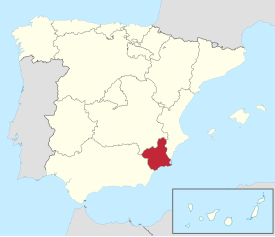
Back Rechión de Murcia AN منطقة مرسية Arabic اقليم مورسيا ARZ Rexón de Murcia AST Mursiya (muxtar icma) Azerbaijani مورسیا AZB Wawengkon Mursia BAN Мурсія (аўтаномная супольнасць) Byelorussian Мурсія (аўтаномная супольнасьць) BE-X-OLD Мурсия (автономна област) Bulgarian
This article needs additional citations for verification. (June 2013) |
Region of Murcia
Región de Murcia (Spanish) | |
|---|---|
 Location of the Region of Murcia within Spain | |
| Coordinates: 38°00′N 1°50′W / 38.000°N 1.833°W | |
| Country | Spain |
| Capital | Murcia |
| Government | |
| • President | Fernando López Miras (PP) |
| Area | |
| • Total | 11,313 km2 (4,368 sq mi) |
| Population (1.1.2020 official estimate)[1] | |
| • Total | 1,511,251 |
| • Density | 130/km2 (350/sq mi) |
| • Pop. rank | 10th |
| • Percent | 3.0% of Spain |
| Demonym(s) | Murcian murciano, -na (es) |
| Ethnic groups | |
| GDP | |
| • Total | €35.809 billion (2022) |
| • Per capita | €23,197 (2022) |
| ISO 3166 code | ES-MC (region) ES-MU (province) |
| Official languages | Spanish |
| Parliament | Regional Assembly of Murcia |
| Congress seats | 10 (of 350) |
| Senate seats | 6 (of 265) |
| HDI (2021) | 0.882[3] very high · 12th |
| Website | Comunidad Autónoma de la Región de Murcia |
 | |
The Region of Murcia (/ˈmʊərsiə/, US also /ˈmɜːrʃ(i)ə/;[4][5][6] Spanish: Región de Murcia [reˈxjon de ˈmuɾθja], Valencian: Regió de Múrcia) is an autonomous community of Spain located in the southeastern part of the Iberian Peninsula, on the Mediterranean coast. The region is 11,313 km2 (4,368 sq mi) in area and had a population of 1,511,251 as at the start of 2020.[7] About a third of its population lives in the capital, Murcia, and a seventh in the second city, Cartagena. At 2,014 m (6,608 ft), the region's highest point is Los Obispos Peak in the Massif of Revolcadores.[8]
A jurisdiction of the Crown of Castile since the Middle Ages, the Kingdom of Murcia was replaced in the 19th century by territory primarily belonging to the provinces of Albacete and Murcia (and subsidiarily to those of Jaén and Alicante).[9] The former two were henceforth attached to a 'historical region' also named after Murcia. The province of Murcia constituted as the full-fledged single-province autonomous community of the Region of Murcia in 1982.
The region is bordered by Andalusia (the provinces of Almería and Granada), Castile La Mancha (the province of Albacete), the Valencian Community (province of Alicante), and the Mediterranean Sea. The autonomous community is a single province. The city of Murcia is the capital of the region and the seat of the regional government, but the legislature, known as the Regional Assembly of Murcia, is located in Cartagena. The region is subdivided into municipalities.[10]
The region is among Europe's largest producers of fruits, vegetables, and flowers, with important vineyards in the municipalities of Jumilla, Bullas, and Yecla that produce wines of Denominación de origen. It also has an important tourism sector concentrated on its Mediterranean coastline, which features the Mar Menor saltwater lagoon. Industries include the petrochemical and energy sector (centered in Cartagena) and food production. Because of Murcia's warm climate, the region's long growing season is suitable for agriculture; however, rainfall is low. As a result, in addition to the water needed for crops, there are increasing pressures related to the booming tourist industry. Water is supplied by the Segura River and, since the 1970s, by the Tagus-Segura Water Transfer, a major civil-engineering project that brings water from the Tagus River into the Segura under environmental and sustainability restraints.
Notable features of the region's extensive cultural heritage include 72 cave art ensembles, which are part of the rock art of the Iberian Mediterranean Basin, a World Heritage Site.[11] Other culturally significant features include the Council of Wise Men of the plain of Murcia and the tamboradas (drumming processions) of Moratalla and Mula, which were declared intangible cultural heritage by UNESCO.[12][13] The region is also the home of Caravaca de la Cruz, a holy city in the Catholic Church that celebrates the Perpetual Jubilee every seven years in the Santuario de la Vera Cruz.[14]
Cite error: There are <ref group=lower-alpha> tags or {{efn}} templates on this page, but the references will not show without a {{reflist|group=lower-alpha}} template or {{notelist}} template (see the help page).
- ^ Municipal Register of Spain 2018. National Statistics Institute.
- ^ "Contabilidad Regional de España" (PDF). www.ine.es.
- ^ "Sub-national HDI – Area Database – Global Data Lab". hdi.globaldatalab.org. Retrieved 2023-06-24.
- ^ "Murcia". Collins English Dictionary. HarperCollins. Retrieved 29 May 2019.
- ^ "Murcia" (US) and "Murcia". Lexico UK English Dictionary. Oxford University Press. Archived from the original on 2020-03-22.
- ^ "Murcia". Merriam-Webster.com Dictionary. Retrieved 29 May 2019.
- ^ La Verdad de Murcia (17 December 2011). "El padrón registra la cuarta mayor subida, con 8.000 habitantes más". Retrieved December 17, 2011.
- ^ Review Geodesic Vertex, Government of Spain (pdf)
- ^ Vilar, María José (1998). "Los orígenes de la delimitación territorial de la Comunidad de Murcia" (PDF). Anales de Historia Contemporánea. 14: 305.
- ^ New Larousse Encyclopedia. Vol. XIV. Barcelona: Editorial Planeta. 1981. p. 6806. ISBN 84-320-4274-9.
- ^ 727 individual codes according to the list of UNESCO
- ^ Las Provincias. El Tribunal de las Aguas de Valencia es designado Patrimonio Cultural Inmaterial de la Humanidad. 30 September 2009.
- ^ "La tamborada de Mula y Moratalla, Patrimonio Inmaterial de la Humanidad por la Unesco". Region of Murcia official website. 29 November 2018.
- ^ "El camino de Santiago. Lugares de Peregrinación de la Cristiandad". 2013.
© MMXXIII Rich X Search. We shall prevail. All rights reserved. Rich X Search

